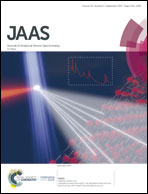Evaluation of inductively coupled plasma tandem mass spectrometry for radionuclide assay in nuclear waste characterisation
Abstract
Decommissioning and monitoring around nuclear sites presents challenges with regards to the range of sample matrices and radionuclides that must be accurately characterised. Over the last few decades, inductively coupled plasma mass spectrometry (ICP-MS) has been increasingly used in the nuclear sector as a rapid alternative to decay counting techniques for long-lived radionuclides, as well as an expanding range of shorter-lived radionuclides. The presence of various interferences still presents a major challenge in achieving accurate measurements, often necessitating extensive chemical clean-up prior to measurement. This study evaluates the potential application of tandem ICP-MS/MS for the measurement of a range of radionuclides of interest to nuclear decommissioning and waste management. The flexibility of the instrumental setup is shown in achieving improved interference removal compared to alternative instrument designs, improving sample throughput by reducing reliance on offline separation, and increasing the potential application of ICP-MS/MS for routine measurement of difficult-to-measure radionuclides.



 Please wait while we load your content...
Please wait while we load your content...